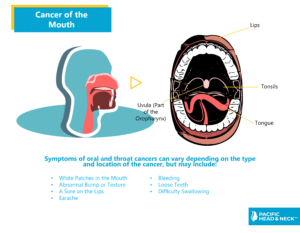
Cancer of the mouth and throat refer to the development of a cancerous tumor within the lips, cheeks, salivary glands, gums, teeth, tongue, tonsils or nearly any other area within these structures. Oral (mouth) and pharyngeal (throat) cancers most commonly affect patients over the age of 40 who smoke or chew tobacco. Excessive alcohol consumption, a family history of head and neck cancer, and exposure to the Human Papilloma Virus (HPV) may also increase a patient’s risk for mouth and throat cancer.
Diagnosis
Tests and procedures used to diagnose cancer of the mouth include:
- Physical Exam:
- Examination of the lips, mouth, areas of irritation (such as sores and white patches).
- Removal of Tissue (Biopsy):
- If a suspicious area is found, with a tissue sample the cells can be analyzed for cancer or precancerous symptoms.
Frequently Asked Questions
Benefits of trans-robotic surgery include:
- Decreasing the likelihood of a tracheostomy, an incision through which surgeons insert a breathing tube
- Decreased risk of long-term speaking or swallowing issues
- Less pain during recovery
- Less medication
- Lower likelihood of visible scars
- Quicker recovery, return to speech, and daily activities
- Reduced blood loss
- Shorter hospital stays
- No visible scarring (No external incision)
- Reduced or eliminated the need for chemotherapy or radiation
Trans-robotic surgery is performed on a variety of head and neck cancers, including:
- Hypopharyngeal Cancer: Affects the lower part of the throat
- Laryngeal (Voice Box) Cancer
- Larynx Cancer
- Tonsil Cancer
- Oropharyngeal Cancer: Affects the back of the throat, base of the tongue or tonsil
- Pyriform Sinus Cancer
- Vallecular Cysts
It may also be performed on noncancerous conditions, including:
- Obstructive Sleep Apnea
- Lingual Tonsillitis: Inflammation of the tonsils at the base of the tongue








